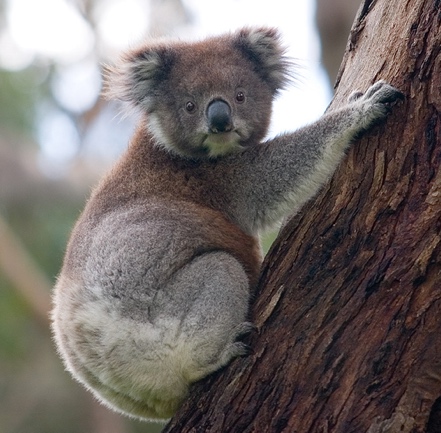
General Information
The only surviving species of the Koala family of marsupials is the Koala, which is not a bear, contrary to popular belief. The closest phylogenetic relatives of koalas are kangaroos and wombats. Koalas’ bodies are wrapped in a layer of short, gray, or less frequently brown fur, apparently for protection against larger predators. Koalas live in trees most of the time. The unique shape of the marsupial’s teeth justifies its herbivorous lifestyle. Koalas’ habitat is unequivocal and restricted to mainland Australia: outside the South Polar Continent, koalas do not live in the wild. A born cub stays in its mother’s pouch for the next six months, feeding on the female’s milk. As it matures, the koala cub emerges from the pouch and clings tightly to its mother’s back to move with her.
Skull structure
The structure of the jaw of koalas is typical of all marsupials: a movable lower jaw and a fixed upper one, both wrapped in a dense layer of tiny teeth. Notably, the front four teeth of koalas resemble the jaw structure of rodents; they are elongated and sharpest. The lower jaw is fused with the upper jaw in the zygomatic area of the skull. The skull of koalas, compared to the overall size of the body, is large, with depressions under the eyes comparatively small. A peculiarity of koalas is developed hearing, so there are developed ear canals in the skull. The nostril openings are also larger than usual, which improves the olfactory skills of koalas. The cerebral cavity of koalas is significantly reduced compared to the ancestors, evidence of the transition to an exclusively herbivorous diet.
Structure of the postcranial skeleton
The arboreal lifestyle of koalas has adapted their limbs for tenacity: the forelegs have sharp claws that enhance attachment to tree bark. Each of the limbs ends in five toes. Two of the toes of the forelimbs are opposed by three forward-pointing ones, which is necessary for a firmer grip on tree trunks during climbing. On the hind limbs of koalas, the four central toes point forward, and one, the thumb, has no claw and is directed sideways. The Koala’s limbs are well developed; the marsupial animal has long forearms and shins. At the same time, the body of a koala is comparably tiny, reaching only 85 centimeters and weighing up to 15 kilograms. Interestingly, the Koala has a noticeably short tail, which is almost invisible when viewed from the outside. The spine has two natural curves, with the vertebrae thickening as they approach the lumbar spine.